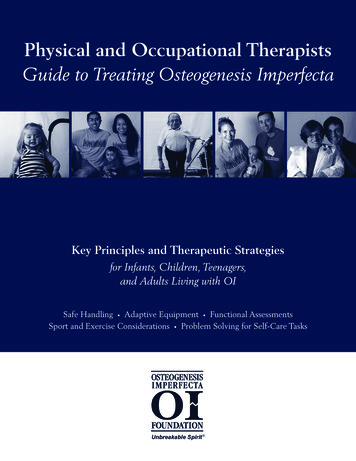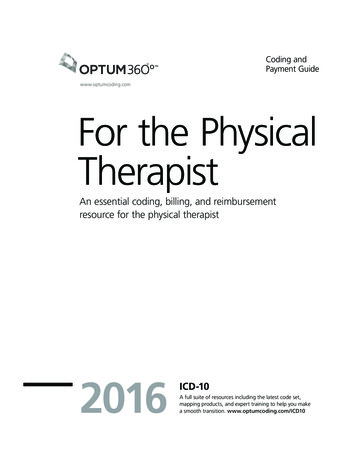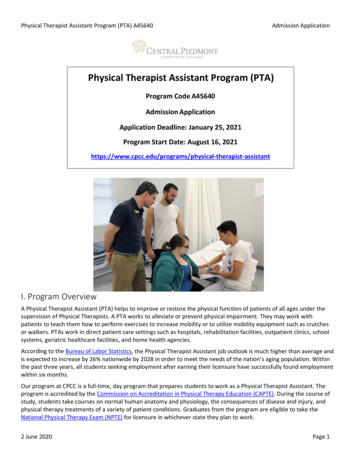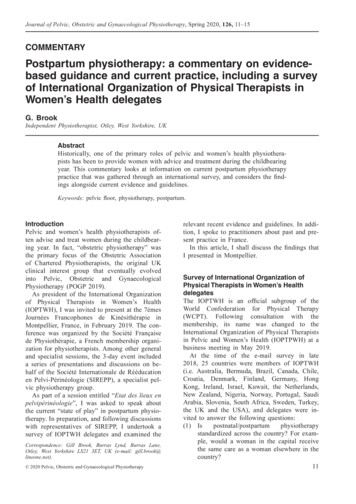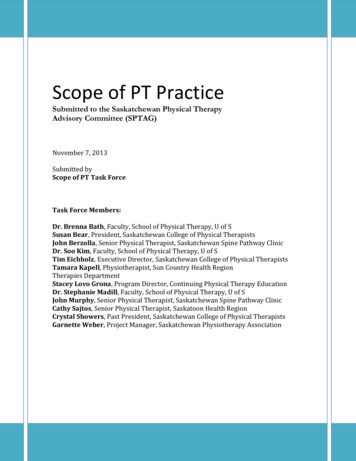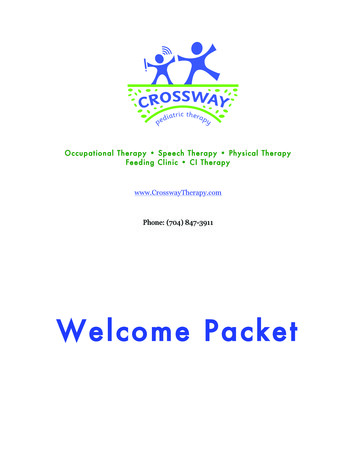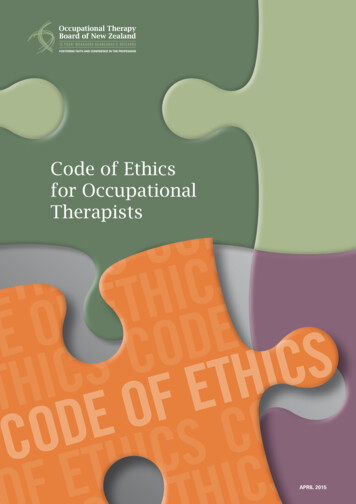
Transcription
Clinical PracticeGuidelineRole of Physical Therapists in theManagement of Individuals at Riskfor or Diagnosed With VenousThromboembolism: Evidence-BasedClinical Practice GuidelineEllen Hillegass, Michael Puthoff, Ethel M. Frese, Mary Thigpen, Dennis C. Sobush,Beth Auten; for the Guideline Development GroupThe American Physical Therapy Association (APTA), in conjunction with the Cardiovascular &Pulmonary and Acute Care sections of APTA, have developed this clinical practice guideline toassist physical therapists in their decision-making process when treating patients at risk forvenous thromboembolism (VTE) or diagnosed with a lower extremity deep vein thrombosis(LE DVT). No matter the practice setting, physical therapists work with patients who are at riskfor or have a history of VTE. This document will guide physical therapist practice in theprevention of, screening for, and treatment of patients at risk for or diagnosed with LE DVT.Through a systematic review of published studies and a structured appraisal process, keyaction statements were written to guide the physical therapist. The evidence supporting eachaction was rated, and the strength of statement was determined. Clinical practice algorithms,based on the key action statements, were developed that can assist with clinical decisionmaking. Physical therapists, along with other members of the health care team, should workto implement these key action statements to decrease the incidence of VTE, improve thediagnosis and acute management of LE DVT, and reduce the long-term complications of LEDVT.E. Hillegass, PT, EdD, CCS,FAACVPR, FAPTA, Department ofPhysical Therapy, Mercer University, 220 Lackland Ct, Atlanta, GA30350 (USA). Address all correspondence to Dr Hillegass at:ezhillegass@gmail.com.M. Puthoff, PT, PhD, GCS, Department of Physical Therapy, StAmbrose University, Davenport,Iowa.E.M. Frese, PT, DPT, MHS, CCS,Department of Physical Therapy,St Louis University, St Louis,Missouri.M. Thigpen, PT, PhD, NCS,Department of Physical Therapy,Brenau University, Gainesville,Georgia.D.C. Sobush, PT, MA, DPT, CCS,CEEAA, Department of PhysicalTherapy, Marquette University,Milwaukee, Wisconsin.B. Auten, MLIS, MA, AHIP, Library,South Piedmont Community College, Monroe, North Carolina.See eAppendix 1 (available atptjournal.apta.org)forbriefauthor biographies.[Hillegass E, Puthoff M, Frese EM,et al; for the Guideline Development Group. Role of physical therapists in the management of individuals at risk for or diagnosedwith venous thromboembolism:evidence-based clinical practiceguideline. Phys Ther. 2016;96:143–166.] 2016 American Physical TherapyAssociationPublished Ahead of Print:October 29, 2015Accepted: September 24, 2015Submitted: May 12, 2015Post a Rapid Response tothis article at:ptjournal.apta.orgFebruary 2016Volume 96Number 2Physical Therapy f143
Management of Individuals With Venous ThromboembolismVenous thromboembolism (VTE) isthe formation of a blood clot in adeep vein that can lead to complications, including deep vein thrombosis(DVT), a pulmonary embolism (PE), orpostthrombotic syndrome (PTS). Venousthromboembolism is a serious condition,with an incidence of 10% to 30% of people dying within 1 month of diagnosis,and half of those diagnosed with a DVThave long-term complications.1 Evenwith a standard course of anticoagulanttherapy, one third of individuals willexperience another VTE within 10years.1 For those who survive a VTE,quality of life can be decreased due tothe need for long-term anticoagulation toprevent another VTE.2No matter the practice setting, physicaltherapists work with patients who are atrisk for or have a history of VTE. Additionally, physical therapists are routinelytasked with mobilizing patients immediately after diagnosis of a VTE. Because ofthe seriousness of VTE, the frequencythat physical therapists encounterpatients with a suspected or confirmedVTE, and the need to prevent future VTE,the American Physical Therapy Association (APTA) in conjunction with the Cardiovascular & Pulmonary and Acute Caresections of APTA, support the development of this clinical practice guideline(CPG). It is intended to assist all physicaltherapists in their decision making process when managing patients at risk forVTE or diagnosed with a lower extremitydeep vein thrombosis (LE DVT).In general, CPGs optimize the care ofpatients by building upon the best evidence available while examining thebenefits and risks of each care option.3The VTE Guideline Development Group(GDG) followed a systematic process towrite this CPG with the overall objectiveof providing physical therapists with thebest evidence in preventing VTE, screening for LE DVT, mobilization of patientswith LE DVT, and management of complications of LE DVT. Specifically, thisCPG will: Discuss the role of physical therapists in identifying patients who areat high risk for a VTE and actionsthat can be taken to decrease therisk of a first or recurring VTE.144fPhysical TherapyVolume 96 Provide physical therapists withspecific tools to identify patientswho may have an LE DVT and determine the likelihood of an LE DVT. Assist physical therapists in determining when mobilization is safefor a patient diagnosed with an LEDVT based on the treatment chosen by the interprofessional team. Describe interventions that willdecrease diagnosis complications,such as PTS or another VTE. Create a reference publication forhealth care providers, patients, families and caretakers, educators, policy makers, and payers on the bestcurrent practice of physical therapist management of patients at riskfor VTE and diagnosed with an LEDVT. Identify areas of research that areneeded to improve the evidencebase for physical therapist management of patients at risk for or diagnosed with VTE.This CPG, which contains 14 key actionstatements (Tab. 1), can be applied toadult patients across all practice settings,but it does not address or apply towomen who are pregnant or to children.Additionally, this guideline does not discuss the management of PE, upperextremity DVT (UE DVT), or chronicthromboembolic pulmonary hypertension (CTEPH). Although primarily written for physical therapists, other healthcare professionals should find this CPGhelpful in their treatment of patientswho are at risk for or have a diagnosedVTE.Background and Need for aCPG on VTEVenous thromboembolism is a lifethreatening disorder that ranks as thethird most common cardiovascular illness, after acute coronary syndrome andstroke.4 This disorder consists of DVTand PE, 2 interrelated primary conditionscaused by venous blood clots, along withseveral secondary conditions includingPTS and CTEPH.5 From primary and secondary prevention perspectives, the seriousness of VTE development related tomortality, morbidity, and diminished lifequality is a worldwide concern.6 Theincidence of VTE differs greatly amongcountries. For example, the United StatesNumber 2ranges from 70 to 120 cases per 100,000inhabitants per year, and in Europe thereare between 140 and 240 cases per100,000 inhabitants per year, with sudden death being a frequent outcome.7Deep vein thrombosis is a serious, yetpotentially preventable, medical condition that occurs when a blood clot formsin a deep vein, most commonly in thecalf, thigh, or pelvis. A life-threatening,acute complication of LE DVT is PE. Thiscomplication occurs when the clot dislodges, travels through the venous system, and causes a blockage in the pulmonary circulatory system. A proximal LEDVT, defined as occurring in the popliteal vein or veins more cephalad, is associated with an estimated 50% risk of PE ifnot treated, as compared with approximately 20% to 25% of LE DVTs below theknee.8 Approximately 1 in 5 individualswith acute PE die almost immediately,and 40% will die within 3 months.9 Inthose who survive PE, significant cardiopulmonary morbidity can occur, mostnotably CTEPH.Chronic thromboembolic pulmonaryhypertension can be the result of a singlePE, multiple PEs, or recurrent PEs.Acutely, PE causes an obstruction offlow. This narrowing of the lumen maylead to reduced oxygenation and pulmonary hypertension. Chronically, theinfarction of lung tissue following PEmay result in a reduction of vascularization and concomitant pulmonary hypertension. Over time, the workloadimposed on the right heart increases andcontributes to right heart dysfunctionand then failure.10 A new syndrome,post-PE syndrome, has more recentlybeen proposed to capture those patientswith persistent abnormal cardiac andAvailable WithThis Article atptjournal.apta.org eTable: CurrentAnticoagulation Options in Use eAppendix 1: Brief AuthorBiographies eAppendix 2: AGREE II Review ofCurrent GuidelineFebruary 2016
Management of Individuals With Venous ThromboembolismTable 1.Key Action StatementsaNumberStatementKey Phrase1Physical therapists should advocate for a culture of mobility and physical activity unlessmedical contraindications for mobility exist.(Evidence Quality: I; Recommendation Strength: A–Strong)Advocate for a culture of mobility and physicalactivity2Physical therapists should screen for risk of VTE during the initial patient interview andphysical examination.(Evidence Quality: I; Recommendation Strength: A–Strong)Screen for risk of VTE3Physical therapists should provide preventive measures for patients who are identifiedas high risk for LE DVT. These measures should include education regarding signsand symptoms of LE DVT, activity, hydration, mechanical compression, and referralfor medication.(Evidence Quality: I; Recommendation Strength: A–Strong)Provide preventive measures for LE DVT4Physical therapists should recommend mechanical compression (eg, IPC, GCS) whenindividuals are at high risk for LE DVT.(Evidence Quality: I; Recommendation Strength: A–Strong)Recommend mechanical compression as apreventive measure for LE DVT5Physical therapists should establish the likelihood of an LE DVT when the patient haspain, tenderness, swelling, warmth, or discoloration in the lower extremity.(Evidence Quality: II; Recommendation Strength: B–Moderate)Identify the likelihood of LE DVT when signsand symptoms are present6Physical therapists should recommend further medical testing after the completion ofthe Wells criteria for LE DVT prior to mobilization.(Evidence Quality: I; Recommendation Strength: A–Strong)Communicate the likelihood of LE DVT andrecommend further medical testing7When a patient has a recently diagnosed LE DVT, physical therapists should verifywhether the patient is taking an anticoagulant medication, what type ofanticoagulant medication, and when the anticoagulant medication was initiated.(Evidence Quality: V; Recommendation Strength: D–Theoretical/Foundational)Verify the patient is taking an anticoagulant8When a patient has a recently diagnosed LE DVT, physical therapists should initiatemobilization when therapeutic threshold levels of anticoagulants have been reached.(Evidence Quality: I; Recommendation Strength: A–Strong)Mobilize patients who are at a therapeuticlevel of anticoagulation9Physical therapists should recommend mechanical compression (eg, IPC, GCS) when apatient has an LE DVT.(Evidence Quality: II; Recommendation Strength: B–Moderate)Recommend mechanical compression forpatients with LE DVT10Physical therapists should recommend that patients be mobilized, oncehemodynamically stable, following IVC filter placement.(Evidence Quality: V; Recommendation Strength: P–Best Practice)Mobilize patients after IVC filter placementonce hemodynamically stable11When a patient with a documented LE DVT below the knee is not treated withanticoagulation and does not have an IVC filter and is prescribed out of bedmobility by the physician, the physical therapist should consult with the medicalteam regarding mobilizing versus keeping the patient on bed rest.(Evidence Quality: V; Recommendation Strength: P–Best Practice)Consult with the medical team when a patientis not anticoagulated and without an IVCfilter12Physical therapists should screen for fall risk whenever a patient is taking ananticoagulant medication.(Evidence Quality: III; Recommendation Strength: C–Weak)Screen for fall risk13Physical therapists should recommend mechanical compression (eg, intermittentpneumatic compression, graduated compression stockings) when a patient has signsand symptoms suggestive of PTS.(Evidence Quality: I; Recommendation Strength: A–Strong)Recommend mechanical compression whensigns and symptoms of PTS are present14Physical therapists should monitor patients who may develop long-term consequencesof LE DVT (eg, PTS severity) and provide management strategies that prevent themfrom occurring to improve the human experience and increase quality oflife. (Evidence Quality: V; Recommendation Strength: P–Best Practice)Implement management strategies to preventfuture VTEaVTE venous thromboembolism, LE DVT lower extremity deep vein thrombosis, IPC intermittent pneumatic compression, GCS graduated compressionstockings, IVC inferior vena cava, PTS postthrombotic syndrome.February 2016Volume 96Number 2Physical Therapy f145
Management of Individuals With Venous Thromboembolismpulmonary function who do not meetthe criteria for CTEPH.5 These conditions are associated with diminishedfunction and lowered quality of life.11Beyond the threat of PE and its sequelae,LE DVT may lead to long-term complications. Postthrombotic syndrome is themost frequent complication and develops in up to 50% of these patients evenwhen an appropriate anticoagulant isused.12,13 A clot remaining in the vein ofthe lower extremity can obstruct bloodflow, leading to venous hypertension.Additionally, damage to the vein itselfoccurs and leads to inflammation andnecrosis of the vein, which eventuallyare removed by phagocytic cells, leadingto venous hypertension. This impairedblood flow can lead to classic symptomsof PTS, which often includes chronicaching pain, intractable edema, limbheaviness, and leg ulcers.10 This chronicpathology can cause serious long-term illhealth, impaired functional mobility,poor quality of life, and increased costsfor the patient and the health care system.Across various practice settings, physicaltherapists encounter patients who are atrisk for VTE, may have an undiagnosedLE DVT, or have recently been diagnosedwith an LE DVT. The physical therapist’sresponsibility to every patient is 5-fold:(1) prevention of VTE, (2) screening forLE DVT, (3) contributing to the healthcare team in making prudent decisionsregarding safe mobility for thesepatients, (4) patient education andshared decision making, and (5) prevention of long-term consequences of LEDVT. Such decisions should always bemade in collaboration with the referringphysician and other members of thehealth care team (ie, it is assumed thatsuch decisions will not be made in isolation and that the physical therapist willcommunicate with the medical team).Due to the long-standing controversyregarding mobilization versus bed restfollowing VTE diagnosis and with thedevelopment of new anticoagulationmedications, the physical therapy community needs evidence-based guidelinesto assist in clinical decision making. ThisCPG is intended to be used as a referencedocument to guide physical therapist146fPhysical TherapyVolume 96practice in the prevention of, screeningfor, and treatment of patients at risk foror diagnosed with LE DVT. This CPG isbased on a systematic review of published studies on the risks of early ambulation in patients with diagnosed DVTand on other established clinical guidelines on prevention, risk factors, andscreening for VTE and PTS. In addition toproviding practice recommendations,this guideline also addresses gaps in theevidence and areas that warrant furtherinvestigation.MethodsThe GDG, which comprised physicaltherapists with special interest in acutecare and cardiovascular and pulmonarypractice, was appointed by the Cardiovascular & Pulmonary and the AcuteCare sections of APTA to develop aguideline to address the physical therapist’s role in the management of VTE.Specifically, the role of mobility wasidentified as a major issue facing bothsections. Models used by the APTA Pediatric Section for its CPG on physical therapy management of congenital musculartorticollis14 were primarily used todevelop this CPG, as well as other APTAsupported CPGs and international processes. In July 2012, the GDG initiatedthe process under the guidance of APTAand developed a list of topic areas to becovered by the CPG. In addition, topicareas were solicited from clinicians withcontent experience in the area of VTEwho volunteered to assist. A resultant listof topic areas was developed to determine the scope of the CPG and providedthe GPG with limits to the literaturesearch.Literature ReviewA search strategy was developed and performed by a librarian to identify literaturepublished between May 1, 2003, andMay 2014 addressing mobilizationand anticoagulation therapy to preventand treat VTE. Searches were performedin the following databases: PubMed,CINAHL, Web of Science, CochraneDatabase of Systematic Reviews, Database of Abstracts of Reviews of Effects(DARE), and the Physiotherapy EvidenceDatabase (PEDro). Controlled vocabularies, such as MeSH and CINAHL headings,were used whenever possible in additionNumber 2to key words. Results were limited toarticles written in English. The searchstrategy by key words, MeSH terms, anddatabases is shown in Table 2. Using thissearch strategy, 350 out of 8,652abstracts and citations of relevance wereobtained from Web of Science, CINAHL,PubMed, and Cochrane Database of Systematic Reviews.Clinical practice guidelines publishedbetween 2003 and 2014 were searchedincluding the same key words and MeSHterms using the National Guideline Clearinghouse (NGC, http://www.guideline.gov/) database and the Trip database(http://www.tripdatabase.com/).TheNGC database identified 169 guidelines,of which 40 were deemed as appropriateto be reviewed. Three additional guidelines were identified through the Tripdatabase, and the appropriate target populations were included.Method: Literature ReviewProceduresThe results of the literature and guidelinesearches were distributed to the members of the GDG. One member of thegroup reviewed a list of citations, andanother member performed a secondreview of the same list of citations. Articles were included based on whetherkey topics were addressed and theappropriate target populations wereincluded. Case reports and pediatric articles were excluded. The GDG, alongwith clinicians and academicians whovolunteered from both the Cardiovascular & Pulmonary Section and the AcuteCare Section, were invited to review theidentified literature.Reliability of appraisers was establishedprior to articles being reviewed. Selectedarticles were reviewed by 3 individualswho used 1 of 3 critical appraisal toolsadapted from an evidence-based practicetextbook to evaluate each according toits type (ie, critical appraisal for studiesof prognosis, diagnosis, or intervention).15 The Assessment of Multiple Systematic Reviews (AMSTAR) tool wasused for systematic reviews.16 Selecteddiagnosis, prognosis, and interventionarticles and systematic reviews were critically appraised by the GDG to establishtest standards. Interrater reliabilityFebruary 2016
Management of Individuals With Venous ThromboembolismTable 2.Search Strategy by Key Words, MeSH Terms, and DatabasesKey WordsMeSH TermsDatabasesDVT“Venous Thrombosis”“Deep Vein Thrombosis”VTE“Venous Thromboembolism““Pulmonary lity Limitation”“Motor Activity”“Early Ambulation”“Early Activization”“Early Activisation”“Early Mobilization”“Early ctor Xa Inhibitor”“Direct Thrombin Inhibitors”“Direct Thrombin x“International Normalized Ratio““INR”“Prothrombin Time”“Vena Cava Filter*”“Intermittent Pneumatic Compression Devices”“Compression Stockings”“Compression Socks”“Compression Hose”“Compression Hosiery”“Venous Thrombosis”“Pulmonary ation”“Mobility Limitation”“Motor Activity”“Early Ambulation”“Activities of Daily rin Modulating Agents”“Factor Xa/antagonists and inhibitors”“Thrombosis/prevention and control”“Antithrombins”“Citric Acid”“Heparinoids”“Vitamin K/antagonists and inhibitors”“Antithrombin Proteins”“Fibrinolytic Agents”“International Normalized Ratio”“Prothrombin Time”“Vena Cava Filters”“Intermittent Pneumatic Compression Devices”“Stockings, Compression”PubMedCINAHLWeb of ScienceCochrane Database of Systematic ReviewsDatabase of Abstracts of Reviews of Effects (DARE)Physiotherapy Evidence Database (PEDro)among the 4 core group members wasfirst established on test articles. Volunteers completed critical appraisals of thetest articles to establish interrater reliability. Volunteers qualified to be appraiserswith agreement of 90% or more. Appraisers were randomly paired to read each ofthe remaining diagnostic, prognostic, orintervention articles. Discrepancies inscoring between the readers wereresolved by a member of the GDG.February 2016Clinical practice guidelines werereviewed that fit the scope of this CPGand the patient population. Guidelineswere included based on whether keytopics were addressed and the targetpopulations were included. The resultsof the CPG search were reviewed by onemember of the GDG. Four additionalclinical expert volunteers underwenttraining in the Appraisal of Guidelines forResearch and Evaluation II (AGREE II)17tool to evaluate CPGs with subsequentreliability testing being performed on allreviewers.Levels of Evidence and Grades ofRecommendationsThe GDG followed a previously published process on developing physicaltherapy CPGs.14 Table 3 lists criteria usedto determine the level of evidence associated with each practice statement,Volume 96Number 2Physical Therapy f147
Management of Individuals With Venous ThromboembolismTable 3.ical interpretation. The statements areorganized in Table 1 according to theaction statement number, the statement,and the key phrase or action statement.Levels of EvidenceaLevelCriteriaIEvidence obtained from high-quality diagnostic studies, prognostic or prospective studies,cohort studies or randomized controlled trials, meta-analyses or systematic reviews(critical appraisal score 50% of criteria)IIEvidence obtained from lesser-quality diagnostic studies, prognostic or prospective studies,cohort studies or randomized controlled trials, meta-analyses or systematic reviews (eg,weaker diagnostic criteria and reference standards, improper randomization, noblinding, 80% follow-up) (critical appraisal score 50% of criteria)IIICase-controlled studies or retrospective studiesIVCase studies and case seriesVExpert opinionaReprinted from Kaplan S, Coulter C, Fetters L. Developing evidence-based physical therapyclinical practice guidelines. Pediatr Phys Ther. 2013;25:257–270, with permission of Wolters KluwerHealth Inc.with level I as the highest level of evidence and level V as the lowest level ofevidence. Table 4 presents the criteriafor the grades assigned to each actionstatement. The grade reflects the overalland highest levels of evidence availableto support the action statement.Statements that received an A or B gradeshould be considered as well supported.The CPG lists each key action statementfollowed by rating of level of evidenceand grade of the recommendation.Under each statement is a summary providing the supporting evidence and clin-Table 4.Grades of Recommendation for Action StatementsaGradeRecommendationQuality of EvidenceAStrongA preponderance of level I studies but at least 1 level Istudy directly on the topic support therecommendation.BModerateA preponderance of level II studies but at least 1 levelII study directly on the topic support therecommendation.CWeakA single level II study at 25% critical appraisal scoreor a preponderance of level III and IV studies,including statements of consensus by contentexperts support the recommendation.DTheoretical/foundationalA preponderance of evidence from animal or cadaverstudies, from conceptual/theoreticalmodels/principles, or from basic science/benchresearch, or published expert opinion in peerreviewed journals supports the recommendation.PBest practiceRecommended practice based on current clinicalpractice norms, exceptional situations wherevalidating studies have not or cannot be performedand there is a clear benefit, harm, or cost, and/orthe clinical experience of the guidelinedevelopment group.RResearchThere is an absence of research on the topic, orhigher-quality studies conducted on the topicdisagree with respect to their conclusions. Therecommendation is based on these conflictingconclusions or absent studies.aReprinted from Kaplan S, Coulter C, Fetters L. Developing evidence-based physical therapy clinicalpractice guidelines. Pediatr Phys Ther. 2013;25:257–270, with permission of Wolters Kluwer Health Inc.148fPhysical TherapyVolume 96Number 2AGREE II ReviewThis CPG was evaluated by 5 GPG members using the AGREE II instrument toassess the methodological quality of theguideline. The 5 members scored thisguideline as high quality according to theAGREE II tool (eAppendix 2, available atptjournal.apta.org).External Review Process byStakeholdersThis CPG underwent 2 formal reviews.First, draft reviewers were invited stakeholders representing the American College of Chest Physicians, Society for Vascular Nursing, physical therapy cliniciansand researchers, and patient representatives. The second draft was posted forpublic comment on both the APTA Cardiovascular & Pulmonary Section andAcute Care Section websites; noticeswere sent via email and an electronicnewsletter to Cardiovascular & Pulmonary Section members, literature appraisers, and clinicians who inquired aboutthe CPG during its development.Document StructureThe action statements organized in Table1 are introduced with their assigned recommendation grade, followed by a standardized content outline generated byBRIDGE-Wiz software (http://gem.med.yale.edu/BRIDGE-Wiz/).18 Each statement has a content title, a recommendation in the form of an observable actionstatement, indicators of the evidencequality, and the strength of the recommendation. The action statement profiledescribes the benefits, harms, and costsassociated with the recommendation; adelineation of the assumptions or judgments made by the GDG in formattingthe recommendation; reasons for anyintentional vagueness in the recommendation; and a summary and clinical interpretation of the evidence supporting therecommendation. The Delphi processwas used to determine level of evidenceand recommended strength for each keyaction statement. Each member of theGPG reviewed the supporting evidencefor each key action statement and votedFebruary 2016
Management of Individuals With Venous ThromboembolismKey Action StatementsWith EvidenceAction Statement 1: Advocate fora culture of mobility and physicalactivityPhysical therapists and other healthcare practitioners should advocatefor a culture of mobility and physicalactivity. (Evidence Quality: I; Recommendation Strength: A–Strong)Figure 1.Algorithm for screening for risk of venous thromboembolism (VTE).on level of evidence and strength of recommendation independent of the othergroup members using a Google surveyupon which all votes were tallied andthen reported.Scope of the GuidelineThis CPG uses literature available from2003 through 2014 to address the follow-ing aspects of physical therapists’ management of patients with potential ordiagnosed VTE. The CPG addresses theseaspects of VTE management via 14action statements. Clinical practice algorithms (Figs. 1, 2, and 3), based on thekey action statements, were developedthat can assist with clinical decisionmaking.Action statement profileAggregate Evidence Quality: Level IBenefits: Decreased likelihood of LEDVT and/or PE and/or PTSRisk, Harm, Cost: Injuries from fallsBenefit-Harm Assessment: Preponderance of benefitValue Judgments: Physical therapistsshould advocate for mobility in all situations due to the evidence on the benefitsof activity and risks associated with inactivity and bed rest except when therecould be a risk of harm (eg, embolidepositing in the pulmonary system).Intentional Vagueness: NoneRole of Patient Preferences: As theevidence for risks associated with inactivity is strong and with little associatedrisk of mobility in the absence of thromboembolism, patients should be edu-Figure 2.Algorithm for determining likelihood of a lower extremity deep vein thrombosis (LE DVT). DVT deep vein thrombosis.February 2016Volume 96Number 2Physical Therapy f149
Management of Individuals With Venous ThromboembolismFigure 3.Algorithm for mobilizing patients with known lower extremity deep vein thrombosis. DVT deep vein thrombosis, LMWH low-molecularweight heparin, UFH unfractionated heparin, NOAC novel oral anticoagulants, INR international normalized ratio, IVC inferior venacava. *If started on Coumadin, LMWH usually also started. Use LMWH guidelines for mobilization decision in these situations.cated regarding the benefits of mobilityand encouraged to maintain mobility asmuch as possible to decrease the risk ofadverse outcomes.Exclusions: NoneSummary of evidenceReduced mobility is a known risk factorfor VTE, yet the quantity and duration ofthe reduced mobility that defines degreeof risk for VTE are not known.19 –21 Significant variability exists in the literatureregarding reduced mobility and theresulting risk for VTE.22 Patients whowere ambulatory were found to be atincreased risk for developing a VTE witha standing time of 6 or more hours (oddsratio [OR] 1.9) or resting in bed or achair (OR 5.6).23 Lik
February 2016 Volume 96 Number 2 Physical Therapy f 143. V enous thromboembolism (VTE) is the formation of a blood clot in a deep vein that can lead to compli-cations, including deep vein thrombosis (DVT), a pulmonary embolism (PE), or postthrombotic syndrome (PTS). Venous
